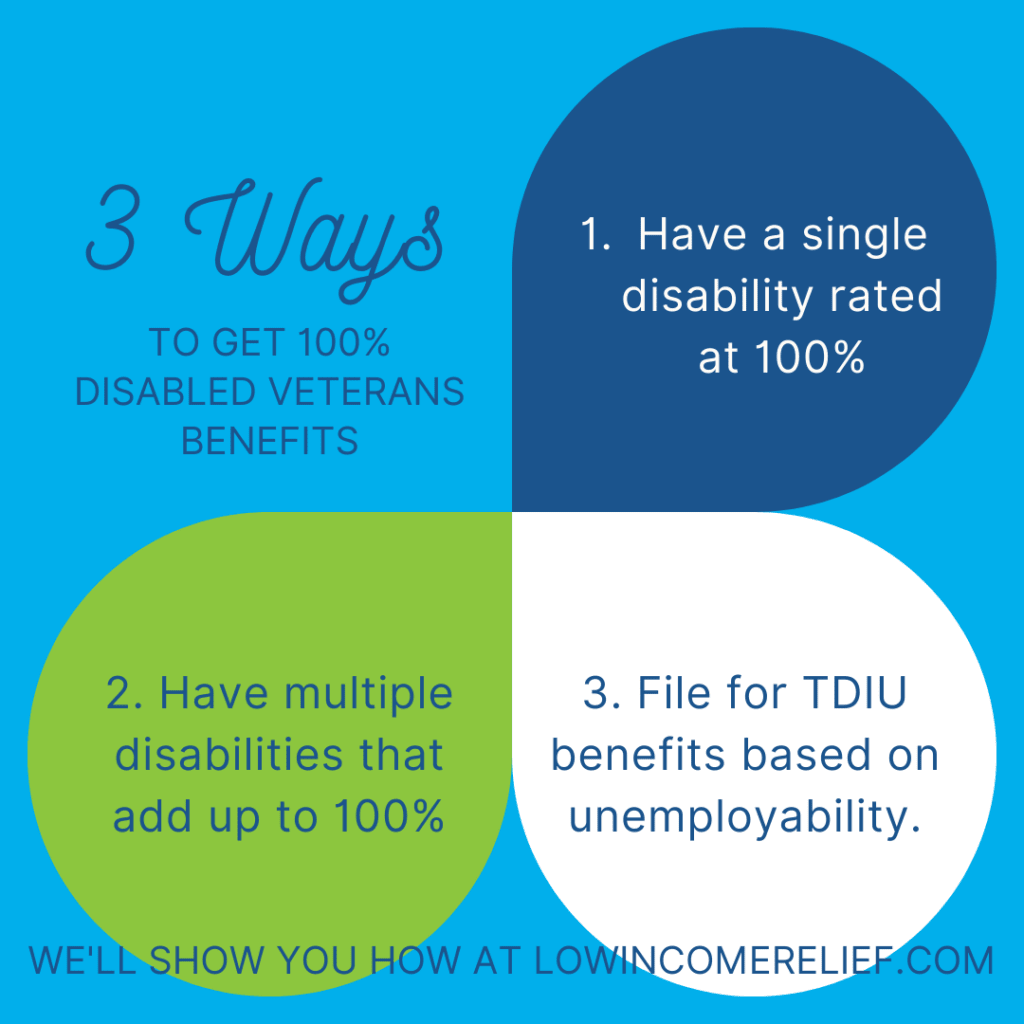Wondering how to get a 100% disabled veteran benefits rating from the VA? You may assume that you need to have a single disability rated at the 100% level but that’s actually not true. There are three ways that you can get a 100% rating from the Department of Veterans Affairs and some are easier than others.
I’ve used these strategies to win multiple 100% claims.
Whenever you read an article online, it’s important to know why you should trust the author. After all, anybody can publish an article online.
However, I have extensive experience with the Department of Veterans Affairs. My husband is a veteran and so is my father-in-law. I have filed claims for both of them and they are both compensated at the 100% level. My husband receives his compensation because of Individual Unemployability (as described below). My father-in-law, on the other hand, has multiple conditions rated at over 100% because of the claims that I filed on his behalf. This actually entitles him to Special Monthly Compensation (SMC) in excess of the typical 100% rating.
In the most recent decision, the VA Board of Appeals stated that I was both “clear and competent” in my arguments. We received almost every rating that I asked for in the Statement of Claim (and there were over half a dozen ratings involved in that claim).
Obviously, I have a lot of experience dealing with the VA and I know what I’m talking about.
It’s hard to get 100% for a single disability.
The first, and most obvious, way to get a 100% disabled veteran benefits rating is to have a single disability that is considered completely disabling. This is a lot harder than it sounds. Even if you think your condition is completely disabling, the VA might not agree.
Many veterans don’t know this, but the VA rates disabilities according to a schedule, or rulebook. The rulebook can be found in 38 CFR Book C. It includes a list of disabilities that are recognized by the VA. Each disability contains a list of symptoms and the percentages that align with those symptoms. In order to get a certain percentage, your condition has to more closely match the list of symptoms for that percentage.
For example, let’s look at the schedule for sleep apnea. The schedule shows that sleep apnea disabilities are rated as follows:
| 6847 Sleep Apnea Syndromes (Obstructive, Central, Mixed) | % Disability Rating |
| Chronic respiratory failure with carbon dioxide retention or cor pulmonale, or; requires tracheostomy | 100 |
| Requires use of breathing assistance device such as a continuous airway pressure (CPAP) machine | 50 |
| Persistent daytime hypersomnolence | 30 |
| Asymptomatic but with documented sleep disordered breathing | 0 |
Sleep apnea is perhaps one of the most straightforward disabilities that is evaluated by the Department of Veterans Affairs. If you have a diagnosis, it’s 0. If you are tired during the day, it’s 30. If you use a CPAP, it’s 50. If you need a trach or have chronic respiratory failure with retention or cor pulmonale, then you can get that 100% disabled veteran benefits rating.
For most other conditions, the list is not as straightforward. The symptoms can be overlapping and very confusing.
For example, this is the table for hypothyroidism:
| 703 Hypothyroidism | % Disability Rating |
| Hypothyroidism manifesting as myxedema (cold intolerance, muscular weakness, cardiovascular involvement (including, but not limited to hypotension, bradycardia, and pericardial effusion), and mental disturbance (including, but not limited to dementia, slowing of thought and depression)) Note (1): This evaluation shall continue for six months beyond the date that an examining physician has determined crisis stabilization. Thereafter, the residual effects of hypothyroidism shall be rated under the appropriate diagnostic code(s) within the appropriate body system(s) (e.g., eye, digestive, and mental disorders) | 100 |
| Hypothyroidism without myxedema Note (2): This evaluation shall continue for six months after initial diagnosis. Thereafter, rate residuals of disease or medical treatment under the most appropriate diagnostic code(s) under the appropriate body system (e.g., eye, digestive, mental disorders). Note (3): If eye involvement, such as exophthalmos, corneal ulcer, blurred vision, or diplopia, is also present due to thyroid disease, also separately evaluate under the appropriate diagnostic code(s) in § 4.79, Schedule of Ratings – Eye (such as diplopia (DC 6090) or impairment of central visual acuity (DCs 6061-6066)). | 30 |
As you can tell, the rules for hypothyroidism are a lot more complicated than the rules for sleep apnea. Some disabilities are more straightforward than others but the 100% criteria is always hard to meet.
Each disability has its own table like this. You can find them all published in 38 CFR Book C Chapter 1 Part 4 Subpart B.
As you look through that folder, remember to reference §4.7. This section is called “Higher of Two Evaluations” and it clearly states that you don’t have to meet all the criteria of the higher rating as long as you meet most of the criteria for that rating.
“Where there is a question as to which of two evaluations shall be applied, the higher evaluation will be assigned if the disability picture more nearly approximates the criteria required for that rating. Otherwise, the lower rating will be assigned.”
38 CFR Book C Chapter 1 Part 4 Subpart A § 4.7 “Higher of Two Evaluations”
This reference is a linchpin argument in all of my VA claims, because it shows that the VA should assign the higher 100% disabled veteran benefits rating as long as your disability more closely resembles that higher rating.
Another clause you’ll want to remember is §4.3. This section is called “Resolution of Reasonable Doubt” and it states that the VA should always resolve the case in favor of the veteran when there is reasonable doubt.
“It is the defined and consistently applied policy of the Department of Veterans Affairs to administer the law under a broad interpretation, consistent, however, with the facts shown in every case. When after careful consideration of all procurable and assembled data, a reasonable doubt arises regarding the degree of disability such doubt will be resolved in favor of the claimant.”
38 CFR Book C Chapter 1 Part 4 Subpart A § 4.3 “Resolution of Reasonable Doubt”
You can also get a 100% disabled veteran benefits rating due to hospitalization, although this rating will not be permanent and total. The temporary increase will expire after six months following your hospitalization.
Combined disabilities are added using complex math.
Most veterans have more than one service connected disability, which should make it easier to reach the 100% disabled veteran benefits level.
Unfortunately, the way the VA calculates multiple ratings makes it extremely difficult to naturally reach the 95% total combined rating required to round up to a 100% rating. Even a 94% rating will be rounded down to 90%.
Just like everything else, math is not simple or straightforward with the VA. You can’t just add two 50% disabilities together and get 100%! In fact, two 50% disabilities will only equal a 75% rating.
That’s because the combined ratings table is intended to reflect how efficient (or non-disabled) you are. Consider this explanation taken from 38 CFR Book C Chapter I Part 4 Subpart A §4.25:
“A person having a 60 percent disability is considered 40 percent efficient. Proceeding from this 40 percent efficiency, the effect of a further 30 percent disability is to leave only 70 percent of the efficiency remaining after consideration of the first disability, or 28 percent efficiency altogether. The individual is thus 72 percent disabled, as shown in table I opposite 60 percent and under 30 percent.”
38 CFR Book C Chapter I Part 4 Subpart A §4.25, “Combined Ratings Table”
It’s actually really difficult to explain how to use the VA’s combined ratings table, so I’ll just summarize a few of the possible combined ratings that could reach a 100% combined rating.
- One 90% rating and one 50% or higher rating
- Two 80% ratings
- One 70% rating and two 60% ratings
- One 60% rating, one 50% rating, two 40% ratings and one 30% rating
- Four 50% ratings and a 10% or higher rating.
- Six 40% ratings
As you can see, if your highest-rated disability is less than 50% then it is nearly impossible to reach a 100% combined rating.
Luckily, it’s a lot easier to reach a 100% disabled veteran benefits rating using TDIU, which I will describe next.
TDIU is the easiest way to get 100% disabled veteran benefits.
A recent study found that of the 2,636,979 veterans being compensated at the 100% level, only 228,364 of them had reached the 100% compensation level without Individual Unemployability. That’s only 8.66% of veterans who successfully scored a 100% rating by some means other than TDIU!
Obviously, the easiest way to get to the 100% disabled veteran benefit level is to apply for Total Disability based on Individual Unemployability (TDIU). This is much easier than trying to use the combined rating table to reach the nearly-impossible 100% level.
In Title 38 Book C Chapter I Part 4 Subpart A §4.18, the VA rulebook states:
A veteran may be considered as unemployable upon termination of employment which was provided on account of disability, or in which special consideration was given on account of the same, when it is satisfactorily shown that he or she is unable to secure further employment.
Title 38 Book C Chapter I Part 4 Subpart A §4.18, “Unemployability”
In order to apply for Total Disability based on Individual Unemployability (TDIU or IU), you must meet both of these requirements:
- You must have at least one disability that is rated at least 60% disabling (or at least two disabilities with one rated at 40% or more and a total rating of 70% or more); AND
- You must be unable to hold a steady job that supports you financially because of your disability. Your ability to get odd jobs doesn’t count against you. This refers to steady, gainful employment.
In some rare cases, you may qualify even if you don’t meet the first criteria if you are frequently hospitalized or meet other special circumstances.
If you qualify for TDIU and your claim is approved, you will receive compensation at the 100% level. Your depends will receive CHAMPVA health care, education benefits, and other perks associated with receiving 100% disabled veteran benefits. It is truly life-changing for those that qualify.

Don’t miss out on your other 100% disabled veteran benefits.
There are many benefits out there for veterans, especially those who are compensated at the 100% level. Among other things, you may qualify for:
- Free National Parks passes
- Free State Parks passes
- Free Lifetime Car Registration
- Property Tax Exemptions
- and more.
If you require the assistance of a caregiver, you may be able to get even more benefits through the VA’s Comprehensive Program for Family Caregivers.

